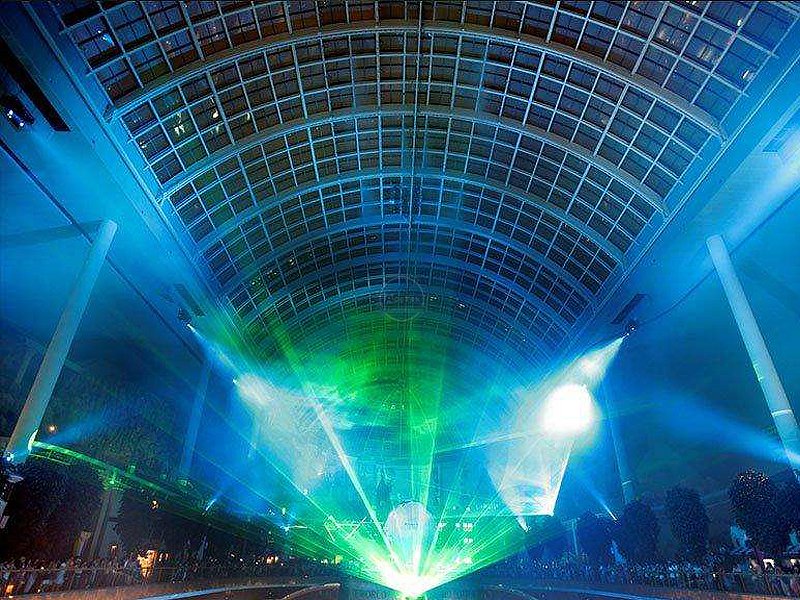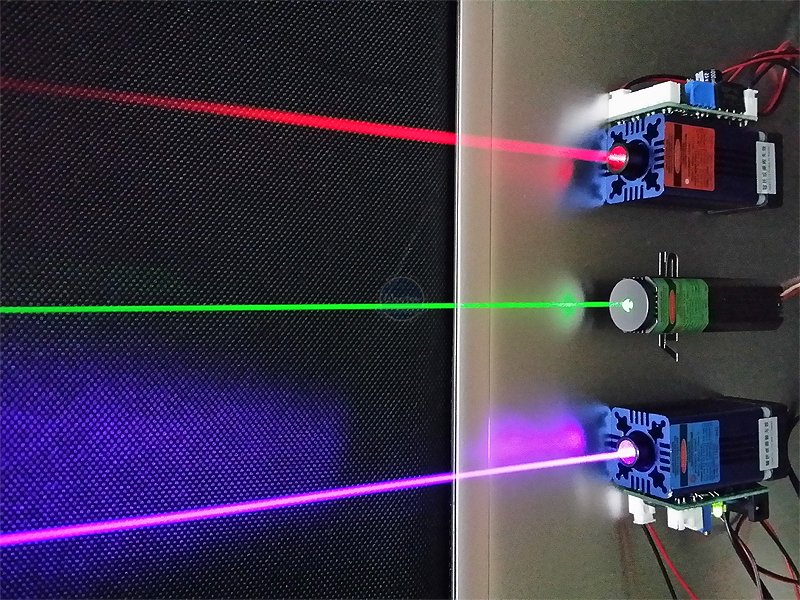
Danger of laser
The high intensity of laser light creates an extremely violent Photochemical, Photothermal, Photodynamic, photostripping, light-wave electromagnetic disruption in living tissues, causing significant damage.Surrounding equipment, especially flammable and explosive materials, can also cause disasters.Interference caused by high congruency makes the light on Constructive interference stronger, thus resulting in higher damage.
Danger to the eyes
The Cornea and Conjunctiva of the human eye, which are not protected by the normal cuticle of the skin, are most vulnerable to the attack of light beams and other environmental factors.The intensity of the laser light is so high that the eyelid reflex can cause damage before it is protective.
Damage done to the eye is related to wavelengths: IR-A, in Visible light and Infrared, affects the retina;Ultraviolet (UV-B, UV-C, and infrared IR-B and IR-C affect the cornea.)Visible and short-wave infrared;Ir-a) will pass through the clear eye material, which will be absorbed by the retina, so if the beam is too strong, it will damage the retina.The high Collimation of laser light allows light to converge on a very small point, about 10 to 20 m (thinner than a hair) on the retina.As a result, lasers at a distance of between 400nm and 1,400 nm present a particularly high risk to the retina, at a band called the Retinal hazard region.
Tissue surrounding the imaging area may also be damaged due to heat flow and Shock waves, with more serious consequences for visual function.Because the retinal nerve tissue repair ability is very low, this kind of damage is generally permanent.
Electromagnetic waves outside the hazardous areas of the retina, including ultraviolet and Far infrared, can damage the front of the eye.Some bands can harm lenses, especially at 295nm to 320nm and 1 m to 2 m.A wide range of ultraviolet rays, as well as infrared rays with a wavelength of more than 1,400 nm, can harm the cornea.When only the corneal epidermis is injured, it can be repaired within a day or two, and the vision is completely restored.If significant damage occurs in the deeper part of the cornea, Corneal scar can result, leading to permanent blindness.
In terms of the Penetration depth of infrared tissues, 1,440 nm(such as some semiconductor lasers), 1,540 nm(such as erbium-glass laser) and 2,100 nm(such as holmium: yag laser) are all greater than 10,600 nm(carbon dioxide laser), so the first three have a high risk of causing permanent damage.The 308 nm xenon chloride (XeCl) laser beam produces an additional Cataract in the crystalline lens.Argon, Krypton, KTP Double frequency, Copper vapor, Gold vapor, heliun-neon, Nd:YAG and other lasers are potentially dangerous to the retina.Erbium-jacques (Er:YAG), Erbium-Yttrium fluoride lithium (Er:YLF), holmium - Jacques (Ho:YAG), hydrogen fluoride (HF), carbon dioxide (CO2), carbon monoxide (CO) and other lasers are dangerous to the cornea

For the skin
Damage to the skin can be caused by photochemical reactions (mainly in the ultraviolet) or thermal effects (mainly in the infrared).For example, Erythema is the result of injury to the epidermis, and sometimes to some extent to the dermis, caused by a photochemical reaction.Knowing the risks makes it easy to plan and implement the skin protection measures needed for Excimer ultraviolet lasers.Visible and infrared laser beams may cause first -, second - and third-degree burns.Irradiance, which can cause severe thermal burns, may also ignite textiles, and the severity of damage to plastic products depends on the length of exposure and the penetration of the laser light.In general, if the exposure lasts for a second or more, the pain response will cause a dodging motion to remove the exposed area from the beam, resulting in exposure for a second or less.A 10.6 m high-power laser will not cause deep tissue burns if exposed for a short period of time because the wavelength of the laser penetrates so shallow (about 20 m) that it does not actually penetrate the normal cuticle thickness.The damage caused by the co2 laser to the cuticle is due to heat transfer from the cuticle to deeper depths.However, when irradiated by the 1064nm neodymium-Jacques short pulse, it can penetrate several mm and enter the tissue, so the amount of exposure just above the burn threshold is enough to cause deep and severe burns.Holmium laser (2.1 microns), KTP laser frequency doubling (twice the frequency of neodymium - Jacques, 532 nm) or argon laser (514.5 nm) and 488 burns caused by the depth, between carbon dioxide and neodymium - Jacques laser spot focus after the surgery, a cluster of irradiance or optical fiber tip, is used to vaporize or stripping, so for the near the focus of skin is extremely dangerous.The reflected laser beam can ignite clothing, causing skin damage and tragic consequences.The actual threshold for skin injury is usually several J/cm2 spectra, and this level of exposure does not occur outside the focal point of the surgical laser.
Measures to prevent
The associated hazards are laser or peripheral objects that may be caused by improper operation or failure or damage, including those caused by changes in the relevant substances during normal operation.This section breaks down such dangers and explains how to prevent them.
1. High-voltage electric shock
Caused by electric leakage or accidental electric shock.This hazard can be avoided if the ground is well grounded, the wires are not broken, and the laser circuit is not touched by non-maintenance personnel.
2. Electric fire
It is caused by short circuit, overloading of electric wires, or the high temperature resistance of electric roadside equipment and the impact of electrical circuits.Check the electrical wiring, distribute the load of the socket and switch properly, and place the surrounding equipment properly to prevent this danger.
3, circuit components burst
In the laser, capacitors and transformers are most likely to explode, causing injury, fire or short circuit, etc.Apart from having maintenance personnel regularly check the condition of these devices and make necessary updates, avoid overuse and guard against poor heat dissipation to prevent such hazards.
4. Other objects burst
A gas or Plasma tube filled with an Active medium in a strong flash light for laser excitation may burst due to accidental collision.These devices should have strong protection against impact and should prevent falling.
5. Danger of cryogenic refrigerant or compressed gas
Cryogenic coolant or compressed gas used in lasers or sensors may cause danger if the container (e.g. cylinder) is unsafe or improperly placed.The way to prevent this danger is to use containers that have passed safety inspections and to place these items securely in accordance with safety regulations.
6. Poisonous gas or dust
Laser vaporizes tissue by light and decomposes it at high temperatures to produce potentially harmful airborne pollutants.The pyrolytic decomposition products, similar to smoke from barbecued meat, contain toxic substances and nitrosamines, which are known to cause cancer.Photochemical reaction products and halogen gas spillover from excimer lasers pose similar risks.
Good masks and other protective equipment, the local ventilation and smoke exhaust equipment with perfect functions, are indispensable safety facilities.The smoke must be properly filtered before it is discharged.
7. Other harmful substances
Tellurium (Te) or cadmium (Cd) in an infrared lens or detector, a solvent and dye for a dye laser, and some objects (such as a transformer) in Polychlorinated biphenyl;PCB, are possible release of toxic substances.When using these substances, it is important to take appropriate precautions so that when these substances are accidentally released, they can be removed quickly to avoid contamination.

● High quality AKJ1530 CO2 laser cutting machine
● ATC CNC Router with a horizontal spindle
● High quality AK30F fiber laser marking machine
● High quality AK20F laser fiber marking machine
● Big news: we're building a new factory
● Polish customer purchased AKM1530 high quality CNC engraving machine
● Heavy duty ATC CNC router with horizontal spindle AKM2030C
● Acctek exhibition footprint
● Cost-effective fiber laser cutting machine AKJ1530F1
● ACCTEK cnc router wishes everyone a Merry Christmas
Get a Free Quote Now!
Useful Link
Recommend Machine
Big discount

Headquarters: 3-1007, Minghu Plaza, No. 777 Minghu West Street,Jinan City / Branch: A2-1-1802, Hanyu Jingu, High-tech Zone, Jinan City
Factory: No. 3 Zone A, Lunzhen Industrial Zone,Yucheng City , Shandong Province
Copyright © Jinan AccTek Machinery Co.,Ltd